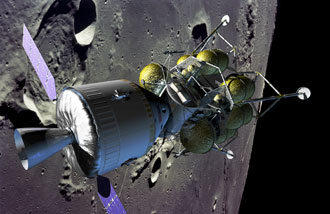Contributed by: filbert Tuesday, September 20 2005 @ 08:56 AM CST
The centerpiece of this system is a new spacecraft designed to carry four astronauts to and from the moon, support up to six crewmembers on future missions to Mars, and deliver crew and supplies to the International Space Station.
The new crew vehicle will be shaped like an Apollo capsule, but it will be three times larger, allowing four astronauts to travel to the moon at a time.
The new spacecraft has solar panels to provide power, and both the capsule and the lunar lander use liquid methane in their engines. Why methane? NASA is thinking ahead, planning for a day when future astronauts can convert Martian atmospheric resources into methane fuel.
The new ship can be reused up to 10 times. After the craft parachutes to dry land (with a splashdown as a backup option), NASA can easily recover it, replace the heat shield and launch it again.
Coupled with the new lunar lander, the system sends twice as many astronauts to the surface as Apollo, and they can stay longer, with the initial missions lasting four to seven days. And while Apollo was limited to landings along the moon’s equator, the new ship carries enough propellant to land anywhere on the moon’s surface.
Once a lunar outpost is established, crews could remain on the lunar surface for up to six months. The spacecraft can also operate without a crew in lunar orbit, eliminating the need for one astronaut to stay behind while others explore the surface.
 Image credit: NASA/John Frassanito and Associates.
Image credit: NASA/John Frassanito and Associates.
